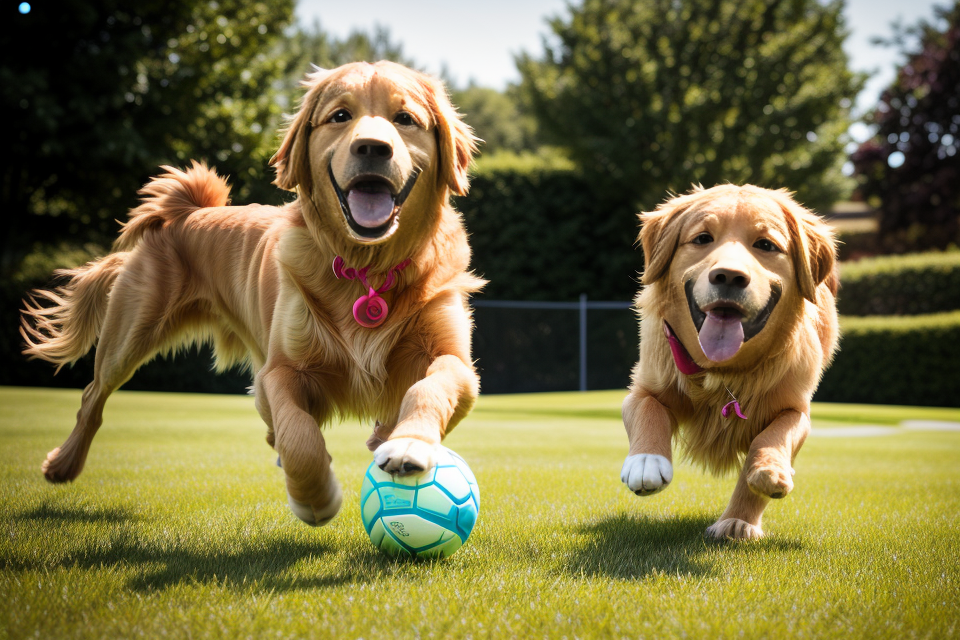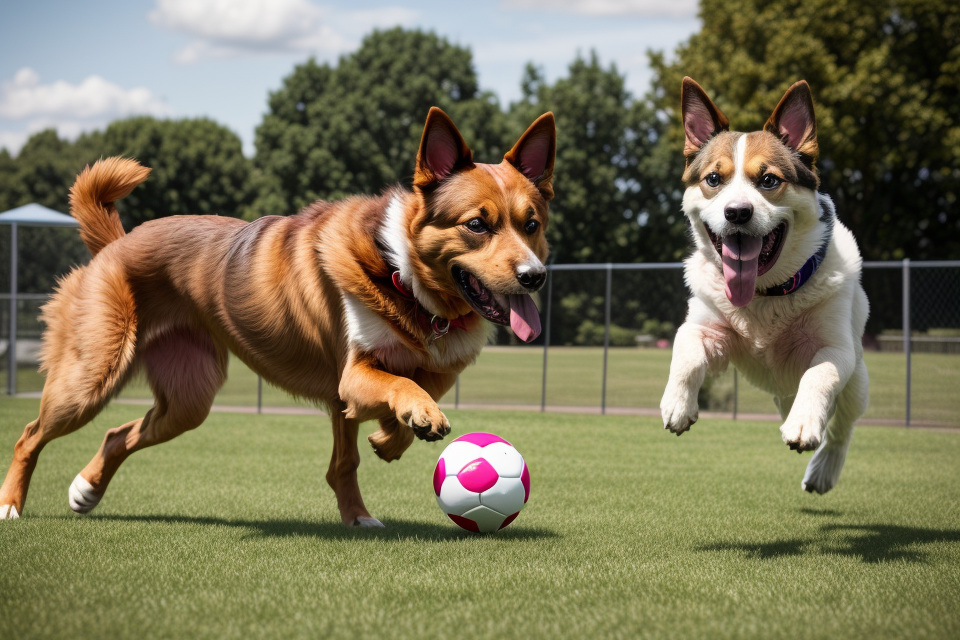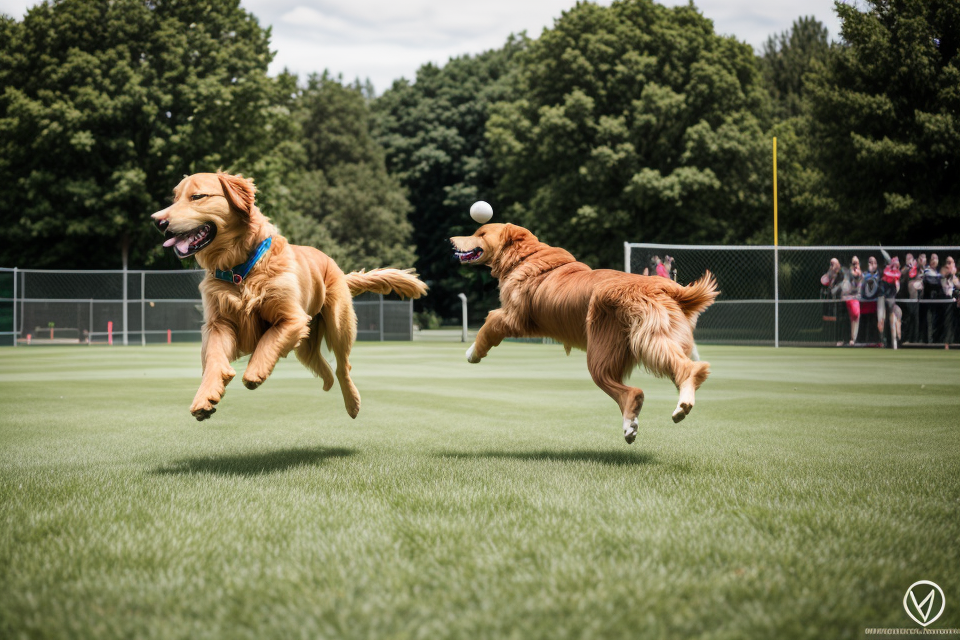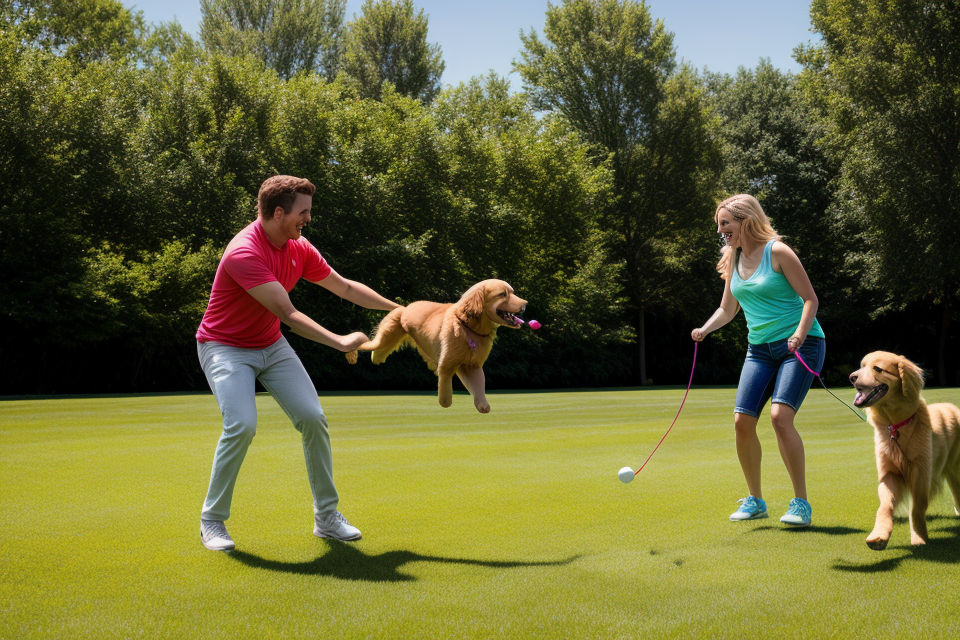Fetch is a fun and engaging game that not only strengthens the bond between a dog and its owner but also helps in the dog’s physical and mental development. However, selecting the right ball for teaching fetch can be a daunting task. The wrong ball can lead to frustration and disappointment for both the dog and the owner. Therefore, it is essential to choose the best ball for teaching fetch. In this article, we will explore the different types of balls suitable for teaching fetch and the factors to consider when making a selection. Whether you’re a seasoned dog owner or a first-time pet parent, this guide will help you make an informed decision and have a great time playing fetch with your furry friend.
The best ball for teaching fetch would be a ball that is durable, easy to grip, and bounces well. A ball made of a soft material like rubber would be ideal, as it would be gentle on a dog’s teeth and gums. The ball should also be small enough for a dog to easily pick up in their mouth, but not so small that it can be swallowed. A ball with a squeaker inside would also be a good choice, as it would provide an added incentive for the dog to bring the ball back. Overall, the best ball for teaching fetch would be one that is both fun and safe for the dog to play with.
Choosing the Right Ball for Fetch
Factors to Consider
When choosing a ball for teaching fetch, there are several factors to consider. These factors include durability, size and weight, bounce, and material.
- Durability: The ball should be durable enough to withstand the wear and tear of regular use. It should be able to withstand the rough play of dogs and the impact of being thrown and caught. Look for balls made from high-quality materials such as rubber or synthetic materials that can withstand the tough play of dogs.
- Size and Weight: The size and weight of the ball should be appropriate for the dog’s size and strength. A small dog will have difficulty handling a large ball, while a large dog will easily knock over a small ball. Choose a ball that is the right size and weight for your dog.
- Bounce: The ball should bounce in a predictable manner, so that the dog can easily catch it. Balls with a consistent bounce are easier for dogs to learn how to catch. Look for balls with a smooth surface and a consistent bounce.
- Material: The ball should be made from a material that is safe for dogs to chew on. Look for balls made from materials such as rubber or plastic that are non-toxic and safe for dogs to chew on.
By considering these factors, you can choose the right ball for teaching fetch to your dog. A high-quality, durable ball that is the right size and weight for your dog, with a consistent bounce and made from safe materials, will help your dog learn how to play fetch and have fun while doing it.
Top Options on the Market
When it comes to teaching fetch, choosing the right ball is crucial. There are several options available on the market, each with its own unique characteristics. Here are some of the top options to consider:
Nylon Balls
Nylon balls are a popular choice for teaching fetch because they are durable and can withstand a lot of wear and tear. They are also lightweight, making them easy for dogs to pick up and carry in their mouths. However, nylon balls can be expensive and may not be suitable for dogs that like to chew on their toys.
Rubber Balls
Rubber balls are another popular option for teaching fetch. They are made from a soft, flexible material that is gentle on a dog’s teeth and gums. Rubber balls are also very bouncy, making them great for games of fetch. However, they can be difficult to pick up for dogs that have a strong grasp, and they may not be suitable for dogs that like to chew on their toys.
Plastic Balls
Plastic balls are a good option for teaching fetch because they are durable and can withstand a lot of wear and tear. They are also lightweight, making them easy for dogs to pick up and carry in their mouths. Plastic balls are also very bouncy, making them great for games of fetch. However, they can be difficult to pick up for dogs that have a strong grasp, and they may not be suitable for dogs that like to chew on their toys.
Indestructible Balls
Indestructible balls are designed to withstand even the toughest chewers. They are made from a durable material that is difficult for dogs to destroy, making them a great option for teaching fetch to powerful chewers. Indestructible balls are also lightweight and bouncy, making them great for games of fetch. However, they can be expensive and may not be suitable for dogs that do not like to chew on their toys.
In conclusion, when choosing a ball for teaching fetch, it is important to consider the needs and preferences of your dog. Nylon, rubber, plastic, and indestructible balls all have their own unique characteristics, and the best option will depend on your dog’s size, strength, and chewing habits.
Benefits of Playing Fetch
To teach fetch, use consistent commands, start with short training sessions, and offer treats and praise. Avoid toxins and monitor playtime to ensure your pet’s safety.
Additionally, the benefits of playing fetch include mental stimulation and physical benefits such as exercise for both pets and owners, as well as strengthening the bond between pets and owners. Training tips for teaching fetch include setting clear expectations, using treats and praise, and keeping play sessions short and frequent.
Mental Stimulation
Playing fetch with a dog provides numerous benefits beyond just physical exercise. One of the most significant advantages of fetch is the mental stimulation it provides. This activity can help enhance a dog’s problem-solving skills and improve their cognitive abilities.
- Enhances Problem-Solving Skills: When playing fetch, dogs are required to use their natural instincts and reasoning abilities to locate and retrieve the ball. This process involves finding the ball, understanding the concept of fetch, and returning the ball to the owner. The process of fetching the ball repeatedly enhances the dog’s problem-solving skills, as they must use their memory and critical thinking to complete the task.
- Improves Cognitive Abilities: Fetching a ball also improves a dog’s cognitive abilities. The process of locating and retrieving the ball requires the dog to use their sense of smell, sight, and hearing. As a result, playing fetch can help improve a dog’s memory, focus, and attention span. It also helps in developing their understanding of the environment and the objects within it.
In conclusion, playing fetch with a dog provides a fun and engaging way to mentally stimulate them. The game enhances their problem-solving skills and improves their cognitive abilities, which are essential for their overall well-being and happiness.
Physical Benefits
Playing fetch is not only a fun activity for both pets and owners, but it also offers a range of physical benefits.
Exercise for Both Pet and Owner
Fetch is a great way to get both pets and owners moving and exercising. Pets get to run around and use their natural instincts to chase and retrieve objects, while owners get to engage in physical activity and bond with their pets. This can help to improve overall physical health and fitness levels for both pets and owners.
Strengthens Bond Between Pet and Owner
Playing fetch is also an excellent way to strengthen the bond between pets and owners. As pets and owners engage in this activity together, they get to spend quality time with each other and build stronger relationships. This can lead to increased trust and loyalty between pets and owners, which can have a positive impact on overall well-being.
Training Tips for Teaching Fetch
Setting Clear Expectations
Use Consistent Commands
One of the most important aspects of teaching fetch is using consistent commands. This means using the same word or phrase every time you ask your dog to fetch a ball. For example, if you always say “fetch” when you want your dog to bring you the ball, you should stick to that command throughout the training process. Using consistent commands helps your dog understand what you want them to do and makes the training process more efficient.
Start with Short Sessions
Another key tip for teaching fetch is to start with short training sessions. This is especially important for younger dogs or dogs that are new to fetch. Start by asking your dog to fetch the ball for just a few minutes at a time, and gradually increase the length of the training sessions as your dog becomes more comfortable and confident. This helps prevent overwhelming your dog and helps ensure that they remain engaged and motivated throughout the training process.
Positive Reinforcement
- Offer Treats and Praise
Positive reinforcement is a highly effective method for teaching fetch to your dog. This approach involves rewarding your dog for good behavior, rather than punishing them for bad behavior. One of the most effective ways to reinforce good behavior is by offering treats and praise.
- Keep Play Sessions Short and Frequent
It’s important to keep play sessions short and frequent when teaching fetch to your dog. This helps to keep them engaged and motivated, and prevents them from becoming overwhelmed or bored. Aim for short, 10-15 minute play sessions several times a day, rather than one long session.
In addition to treats and praise, there are other ways to reinforce good behavior when teaching fetch to your dog. For example, you can offer verbal praise, play with your dog, or give them a toy as a reward for fetching the ball. The key is to find what works best for your dog and to use it consistently.
Fetch Toy Safety Tips
Avoiding Toxins
When selecting a ball for teaching fetch, it is important to prioritize safety. Here are some tips for avoiding toxins in fetch toys:
- Look for Non-Toxic Materials: Choose balls made from non-toxic materials such as rubber, silicone, or natural materials like cotton rope. Avoid balls made from PVC or other chemical-based materials.
- Check for Small Parts or Pieces: Ensure that the ball does not have any small parts or pieces that can be easily detached and ingested by your dog. This includes materials like plastic or metal that can be chewed off and swallowed.
By following these safety tips, you can help ensure that the ball you choose for teaching fetch is safe for your dog to play with and will not cause any harm or injury.
Monitoring Playtime
Supervise Pet During Play
It is crucial to keep a close eye on your pet during playtime to ensure their safety. As you teach your pet to play fetch, monitor their behavior and pay attention to any signs of distress or discomfort. Keep a watchful eye out for any potential hazards or accidents that may occur during play.
Be Mindful of Pet’s Size and Strength
It is important to choose a ball that is appropriate for your pet’s size and strength. If the ball is too small or too hard, it may pose a choking hazard or cause injury to your pet. Conversely, if the ball is too large or too soft, it may be difficult for your pet to pick up and carry, hindering their progress in learning the game of fetch.
The Perfect Ball for Fetch
Our Top Pick
The Fetch Ball is our top pick for teaching fetch due to its unique design and durability. It is made of high-quality materials that can withstand the wear and tear of fetch play, ensuring that it will last for a long time.
One of the key features of the Fetch Ball is its erratic bounce, which makes it more challenging for dogs to catch. This feature helps to keep dogs engaged and interested in the game, even as they improve their fetch skills.
Another advantage of the Fetch Ball is its floatability. It is designed to float in water, making it perfect for games of fetch in the pool or at the beach. This added versatility makes it a great choice for dog owners who want to keep their dogs active and engaged in a variety of environments.
Additionally, the Fetch Ball is available in a range of sizes, so you can choose the perfect size for your dog. This ensures that the ball is the right weight and size for your dog to handle, making it easier for them to catch and retrieve.
Overall, the Fetch Ball is an excellent choice for teaching fetch due to its durability, erratic bounce, floatability, and size options. It is sure to provide hours of fun and exercise for both you and your dog.
Additional Recommendations
When it comes to teaching fetch, the best ball for the job should be durable, easy to throw, and able to withstand the rough play of pets. Here are some additional recommendations for the best balls for teaching fetch:
Ball A: Frisbee
A frisbee is a great option for teaching fetch because it is designed to be thrown and caught. It is also durable and can withstand the rough play of pets. The lightweight design of a frisbee makes it easy for pets to pick up and carry, making it an ideal choice for pets that are just starting to learn fetch.
Ball B: Rubber Ball
A rubber ball is another great option for teaching fetch. Rubber balls are durable and can withstand the rough play of pets. They are also easy to throw and can be picked up by pets with their teeth or mouth. Rubber balls are a good choice for pets that are already experienced with fetch and are looking for a more challenging toy.
Ball C: Squeaky Toy
A squeaky toy is a great option for pets that love to play fetch. Squeaky toys are easy to throw and can be picked up by pets with their teeth or mouth. They are also designed to be durable and can withstand the rough play of pets. The squeaky sound that is made when the toy is squeezed or bitten can also encourage pets to play with the toy more.
In conclusion, when it comes to teaching fetch, the best ball for the job should be durable, easy to throw, and able to withstand the rough play of pets. A frisbee, rubber ball, or squeaky toy are all great options for teaching fetch to pets of all ages and skill levels.
How to Choose the Right Ball for Your Pet
Choosing the right ball for your pet is crucial to ensuring that they have a positive experience while learning the game of fetch. Here are some factors to consider when selecting the best ball for your furry friend:
Consider Your Pet’s Size and Strength
One of the most important factors to consider when choosing a ball for fetch is your pet’s size and strength. Smaller pets, such as toy breeds, may have difficulty handling a ball that is too large or heavy. On the other hand, larger pets, such as German Shepherds, may be able to handle a heavier ball with ease.
It’s important to choose a ball that your pet can comfortably pick up and carry in their mouth. A ball that is too heavy or difficult to handle can cause frustration and discourage your pet from playing the game.
Look for Durable Materials
Another important factor to consider when choosing a ball for fetch is the durability of the materials used. The ball should be made of materials that can withstand the rough play of your pet.
Rubber and vinyl balls are popular choices for fetch because they are durable and easy to clean. They can also withstand the rough play of larger pets without breaking or becoming damaged.
Assess Bounce and Grip
The bounce and grip of the ball are also important factors to consider. A ball that is too bouncy can be difficult for your pet to control, while a ball that doesn’t bounce at all can become easily bored with the game.
A ball with a good grip is also important, as it allows your pet to hold onto the ball more easily. Some balls come with a textured surface that provides a better grip, while others have a ribbed design that helps to keep the ball from slipping out of your pet’s mouth.
Consult with a Veterinarian or Pet Specialist
Finally, it’s always a good idea to consult with a veterinarian or pet specialist when choosing a ball for fetch. They can provide advice on the best ball for your pet’s size, strength, and play style.
Your veterinarian or pet specialist can also advise you on any safety concerns or potential health issues that may arise from playing fetch with a ball. For example, some balls may be too small or hard for pets with dental issues, while others may be too soft and easily damaged by aggressive play.
Overall, choosing the right ball for your pet is essential to ensuring that they have a positive experience while learning the game of fetch. By considering your pet’s size and strength, the durability of the materials, the bounce and grip of the ball, and seeking advice from a veterinarian or pet specialist, you can ensure that your pet is having fun and staying safe while playing fetch.
FAQs
1. What is the best ball for teaching fetch?
The best ball for teaching fetch depends on the dog’s size and play style. For small dogs, a smaller ball that is easy to pick up and carry is recommended. For larger dogs, a ball that is durable and can withstand their strong jaws is ideal. A ball with a squeaker or noise maker can also be helpful in keeping the dog engaged in the game.
2. Can I use a frisbee to teach fetch?
Yes, a frisbee can be used to teach fetch, but it may be more challenging for smaller dogs to pick up and carry. Additionally, a frisbee may not be as durable as a ball and may break easily if your dog has a strong jaw. If you choose to use a frisbee, it’s important to supervise your dog’s playtime and ensure they are not injured.
3. Should I use a ball with a handle for teaching fetch?
A ball with a handle can be helpful for small dogs that have difficulty picking up and carrying a ball. However, a ball with a handle may not be suitable for larger dogs as it can be easily knocked out of their mouth. It’s important to choose a ball that is appropriate for your dog’s size and play style.
4. How long does it take to teach a dog fetch?
The amount of time it takes to teach a dog fetch can vary depending on the dog’s age, breed, and previous experience with playing fetch. Some dogs may catch on quickly, while others may require more time and patience. Consistency and positive reinforcement are key factors in teaching a dog fetch.
5. What is the best age to start teaching fetch?
The best age to start teaching fetch can vary depending on the dog’s breed and size. For small breeds, it may be appropriate to start teaching fetch as early as 3-4 months old. For larger breeds, it may be more appropriate to wait until they are older and their joints are more developed. It’s important to consult with a veterinarian or professional trainer to determine the appropriate age to start teaching fetch for your dog.



